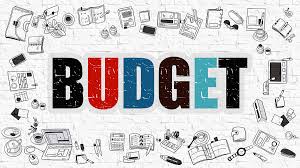Have you experienced a life change recently like having a baby or getting a new house or job? It may be time to review your life insurance coverage! Click the image below to easily find out just how much coverage you should have!



Have you experienced a life change recently like having a baby or getting a new house or job? It may be time to review your life insurance coverage! Click the image below to easily find out just how much coverage you should have!

Budgeting towards needs and goals. One of the objectives of creating a household budget is that, as time moves on and the various household members advance in their careers, they are likely to make more money. Knowing where that money goes can help direct that money to not only meet your day-to-day needs but also to potentially realize your financial goals. Rent payments may become mortgage payments, and socking away a few bucks into your savings each payday could change into an effective financial strategy involving various investment tools.1
Remember that investing involves risk, and the return and principal value of investments will fluctuate as market conditions change. Investment opportunities should take into consideration your goals, time horizon, and risk tolerance. When sold, investments may be worth more or less than their original cost. Past performance does not guarantee future results.
The back of an envelope or a spreadsheet app. Traditionally, a household budget could be worked out “on the back of an envelope.” Of course, this is still true, though you may have access to more bells and whistles than previous generations. Whether you prefer to work it out with pencil and paper or by computer, the main rule is to create and stick to the budget.
Easy come, easy go. Start by taking note of your income. Some Americans have more than one income source, either through a second gig or even a hobby turned small business. You don’t have to be making money very long, though, to realize that it doesn’t always sit still in your checking account. Along with your income, tally up your expenditures: Housing costs (rent, utilities, etc.), groceries, student loan payments, transportation expenses, phone, and Internet, as well as entertainment. It adds up! (More like subtracts, actually.)
Make adjustments. Ideally, the number at the bottom of this reckoning should be a positive number. This means that you’re living within your means and, while you may want to make that a larger number by adjusting your expenses, you’re at a good starting point.
Adjustments are probably overdue if you have a negative number; you’ll need to take a cold hard look at those expenses and think about can I live without (such as mountaineering lessons) and what isn’t going to give (the essentials: food and shelter).
Your other choice, of course, is to make more money. As you move on in your career, this will likely happen as you earn salary increases or build your business. Don’t forget, though, that life gets more expensive over time, as well. Rents and fees will rise as time goes on. Regular adjustments are a natural part of good budgetary maintenance.
Goals and strategies. If you have money coming in that is not being gobbled up by line items on your budget, and you stick to it and keep it that way, you’re (literally) coming out ahead. Now’s the time to put that money to work toward goals and strategies. Goals can be small, like saving up for a vacation or upgrading an item in your home. Or they can be larger, like saving for a major expense.
Goals can work side-by-side with financial strategies, which tend to be “bigger picture” in scope. Financial strategies tend to be things like looking ahead to your retirement or investing in creating more income (so you can get back to mountain climbing). For these bigger strategies and the shorter-term goals, there is an advantage to seeking out a financial professional geared toward helping you get the most from your efforts.
There is no “one way” to budget. There isn’t a single, one-size-fits-all solution for creating and maintaining a household budget. Financial professionals also know this and can help craft a strategy suited to your risk tolerance, goals, and financial situation.

The customer experience is one of the keys to business success. In some industries, it can mean the difference between success and failure.
According to recent research by a major credit card issuer, 90% of Americans consider quality of customer service as they decide whether they want to do business with a company. Another study, conducted by a major business software manufacturer, notes that 93% of customers who get great service from a business are likely to come back and buy again.1
Still, great service remains rare. Customers who want help are often made to feel like they are inconveniencing a business. Some businesses disregard the customer experience, believing that consumers will buy largely on price or a trusted name, as if we were still in the era of dry goods stores and green stamp booklets.
Great customer service is about solving problems and meeting needs. The essentials are simply stated: a quick response, superior communication, putting the customer first. And yet, all this is often absent. As a first step to making these essentials the norm at your company, consider the following questions.
Is your business truly customer focused? Is it evolving in response to customer needs? Are you thinking of your customers and the employees in close contact with them when you think about your brand? Paradoxically, being a customer-focused business means focusing on the experiences of your employees as well as the people who purchase your products or services.
Your employees have to adopt the mindset that they are helpers, problem-solvers for a community of people. They come to work each day to “do good,” and they are the “experts” when it comes to this kind of help; they excel at responding to a specific need.
One of the keys to instilling this mindset is to communicate the values, purpose, and mission of your business. What role does your company play in people’s lives, in the community it serves? What kind of experience should your customers have? Your employees need to hear these things from you.
What kind of community are you creating? Think of your customers and workers as m
embers of the community created around your business. Ask your customers for their opinions of your products or services; involve them strongly in your brand’s evolution and direction. Doing the same with your workers not only gives them a say, but it is also a step toward becoming leaders themselves.
What degree of customer service can your employees deliver? Do they have the authority to give a dissatisfied customer a free product, a full refund, or a unique accommodation? If not, maybe they should be empowered with some of these options. They might just change that unhappy customer into a raving fan.
Are you constantly listening to your clients or customers? If you wonder how things might change in your industry, start by talking to the people who might want to see some change: the consumers. Gather steady feedback from your clients or customers to learn what they want and need now, as opposed to what they wanted and needed years ago when you opened your doors. What you learn may lead you to revise your business plan or direction, and the input will definitely refine the way that your company responds to your customers.


Weekly Economic Update
In this week’s recap: Stocks continued a downward slide in response to continued uncertainty; fiscal stimulus still delayed.
September 14, 2020
Stocks traveled a volatile path last week as investors appeared concerned about the upcoming elections, an uncertain economy, and more delays with additional fiscal stimulus.
The Dow Jones Industrial Average slid 1.66%, while the Standard & Poor’s 500 slumped 2.51%. The Nasdaq Composite index plummeted 4.06% for the week. The MSCI EAFE index, which tracks developed overseas stock markets, rose 1.44%.1,2,3
In a holiday-shortened week of trading, stocks resumed their slide from the prior week, with the technology-heavy Nasdaq slipping into correction territory in a three-day span ended on Tuesday, September 8th. (A correction is defined as a decline of at least 10% from a recent high.)4
After staging a strong rebound on Wednesday, stocks once again headed lower as the Senate failed to pass another coronavirus stimulus bill. Mega-cap technology companies remained under pressure throughout the week. Energy stocks added to investors woes, plunging on data showing an unexpected build-up in inventories.5
The market ended the week on a mixed note, as technology companies lost additional ground.
On Friday the nation commemorated the tragic events of September 11, 2001.
We join all Americans in remembering the lives we lost that day and the profound impact on the victims’ families. We are reminded that it was the unity, kindness, and warmth that we collectively rediscovered in the wake of 9/11 that saw us through that difficult period.
T I P O F T H E W E E K:
Some companies match employee retirement plan contributions. So if your budget allows, contribute enough to qualify for the match.
THE WEEK AHEAD: KEY ECONOMIC DATA
Tuesday: Industrial Production.
Wednesday: Federal Open Market Committee (FOMC) Announcement.
Thursday: Jobless Claims. Housing Starts.
Friday: Leading Economic Indicators.
THE WEEK AHEAD: COMPANIES REPORTING EARNINGS
Tuesday: Adobe Systems (ADBE), Lennar Corporation (LEN), Fedex (FDX).
Q U O T E O F T H E W E E K
“Popularity: it is glory’s small change.”
VICTOR HUGO
T H E W E E K L Y R I D D L E
A plastic bottle filled with cola weighs one liter. What do you need to add to it to make it weigh less than two ounces?
LAST WEEK’S RIDDLE:
If it were two hours later than right now, it would be half as long until midnight as it would be if it were an hour later than right now. What time is it?
ANSWER: 9:00 PM.
Know someone who could use information like this?
Please feel free to send us their contact information via phone or email. (Don’t worry – we’ll request their permission before adding them to our mailing list.)